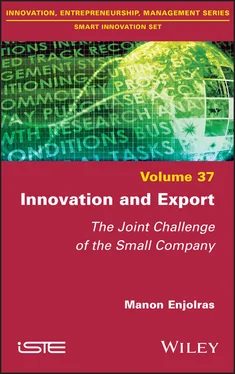On the other hand, innovation has always been synonymous with success for companies, but it was generally considered a privilege reserved for some, mainly the large high-tech multinationals. However, the rapid industrial evolution linked to globalization has led all companies to constantly renew themselves in order to more quickly react to the changing conditions they face: shorter product life cycles, changing customer requirements, an evolving technological environment, aggressive competition and environmental regulations, among others. As a result, SMEs, perhaps even more than other companies, are also affected by these challenges. They are therefore forced to integrate innovation 3into their survival strategy. Nevertheless, managing innovation for small businesses in traditional sectors remains a difficult task. Although an SME is generally considered to be an environment conducive to innovation, it is not always successful (BPI France 2011b). Their flexibility seems to be a major asset, but their lack of access to resources and skills can prove to be a major constraint (Szczepanski 2016). Innovation represents a risk for SMEs, and they are not always able to assume it (European Commission, 2016b). Thus, innovation is clearly identified as a success factor for SMEs, but the difficulties they face hinder the proper management of their internal processes.
Supporting SMEs in their innovation and export activities is, therefore, a major challenge. Indeed, SMEs are the most common form of business organization and the largest provider of employment in the world. Indeed, they represent more than 95% of industrial enterprises in OECD countries (European Commission, 2016a). Consequently, they represent an extremely important economic stake and supporting them in their innovation and export efforts is therefore crucial. It seems essential to help them improve their internal practices in order to change their behavior and improve their performance while adapting to the environment in which they operate.
In this respect, there is currently a real political and economic will to take into account the considerable stakes involved in the development of SMEs. All over the world, numerous support services are offered, at the regional or national level, by public and private institutions. However, and despite the important commitment of the European Union and local authorities (innovation and export have been identified as priorities for action at the European level, such as the Horizon 2020 program), support for SMEs in innovation and international activities is not always adapted.
For example, it seems that current support services are mainly represented by financial or informational incentives (Enjolras et al . 2015). If the main difficulties encountered by SMEs, both for innovation and export, do indeed concern access to resources, it is nevertheless worth questioning the relevance of a temporary increase in resources without the organization and strategy necessary for their proper exploitation being put in place. In the case of incentive schemes, the resources provided to SMEs are mostly ad hoc , without the organizational and strategic difficulties associated with innovation and export being really addressed. Several European Commission reports have emphasized that the most effective type of support seems to be individualized support, as it allows direct action on the internal organization of SMEs by improving their skills and strengthening their resources (Francis and Collins-Dodd 2004). By building skills and changing the routine practices and activities of SMEs, the proposed support appears to be more sustainable and effective (European Commission, 2016b). Thus, it would seem that sustainable and targeted support for SMEs is about empowering them with strategic, comprehensive, and cross-cutting skills and resources.
On the other hand, although the Interreg 2014–2020 strategy devotes an entire axis to increasing the cross-border competitiveness of SMEs and 8 billion euros to SMEs, the support initiatives for SMEs tend to adopt a compartmentalized vision of the aid they offer. Support for innovation and export appear to be two disconnected initiatives, whereas a trend towards coupling these types of support is gradually emerging, according to the European Commission (2007). Indeed, recent studies have shown that companies that are able to manage innovation and international activities are simultaneously more profitable and sustainable over time (Love and Roper 2015).
According to BPI France (2011a), more than one innovative SME in two is present on the international market. This observation highlights the existence of a link between innovation and exporting, and innovation clearly appears to be a driver of international activities. SMEs that innovate are indeed more likely to engage in global markets than non-innovating companies. Process and organizational innovation, for example, can increase company productivity by reducing production costs and enabling SMEs to achieve the minimum level of efficiency required to cover fixed export costs. Through product innovation, marketing innovation and innovative branding strategies, SMEs differentiate their products from those of their competitors, allowing them to gain market share in international markets (OECD 2018). In particular, greater flexibility and a strong ability to customize and differentiate products can give SMEs a competitive advantage in global markets over larger companies, as they are able to quickly respond to changing market conditions and increasingly shorter product life cycles. For example, a report on the behavior of European SMEs (FedEx 2015) shows that fast-growing SMEs are almost twice as likely to export as declining or stagnant SMEs. Indeed, some inter-country niche markets are dominated by SMEs, and small innovative companies often become key partners for large multinationals to develop new products or serve new markets (OECD 2018).
From a theoretical perspective, the study of the link between innovation and export in the context of SMEs represents a very important research topic in the current scientific literature (Love and Roper 2015). Specifically, much work focuses on the direction of causality regarding the impact of one on the other. This paradigm is supported by two theories: self-selection (Monreal-Pérez et al . 2012; Boso et al . 2013; Raymond and St-Pierre 2013) and learning-by-exporting (Kafouros et al . 2008; Golovko and Valentini 2014). Self-selection considers that innovation positively impacts exporting. It is considered a necessary condition for exporting, allowing a company to be sufficiently armed to access international markets. Learning-by-exporting, on the other hand, considers that it is international experiences that promote innovation within companies through the acquisition of technical, commercial, and/or cultural knowledge that enables them to envisage the development of innovations. Whether it is self-selection or learning-byexporting, these two theories consider the link between innovation and export through a causal relationship. They are interested in the impact of one activity on the other and reason in terms of cause and effect. These two theories coexist in the scientific literature and are regularly tested through numerous empirical studies. However, the results greatly diverge from one study to the next, and it is impossible to validate or invalidate either theory from a general perspective (Enjolras et al . 2016).
The study of the link between innovation and export, when studied in terms of causality, thus leads to a controversial debate for which it seems difficult to find a consensus. This is why some studies try to go beyond this causal vision by proposing a vision in terms of complementarities. Innovation and export would not only be activities that have an impact on each other. They would be complementary activities: if we engage in one, it facilitates engagement in the other (Golovko and Valentini 2011). This notion of complementarity also seems to have an impact at the institutional level. There is currently an emerging trend to couple innovation and export support schemes (European Commission 2007), but this is a topic that is very little addressed in the literature. It would seem, therefore, that the study of innovation and export in SMEs requires a different perspective, one that aims to consider them jointly rather than through a cause-and-effect relationship.
Читать дальше












